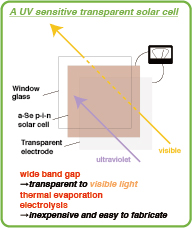Amorphous Selenium based Photovoltaic Devices
The trend of recent solar cells is that it uses cheap material and are highly efficient. Non-silicon materials such as compound semiconductors (e.g. CIGS, CZTS etc.) and organic semiconductors (e.g. P3HT, PCBM etc.) have attracted much attention because of the theoretical efficiency limit of silicon-based solar cells.
Research in the western world has been pushing the limit even more by fabricating a tandem structure of multi-bandgap materials (e.g. dye-sensitized, quantum dot etc.), whereas the world-first prototype quantum dot solar cell module has been reported by researchers at the University of Tokyo, thus national boundaries does not exist within this realm.
Since the nuclear reactor accident after 3.11, the demand of a large-scale renewable energy sources as a replacement for atomic power has increased rapidly in Japan. While the implementation of a new power plant can be time consuming, Japanese researchers has announced many small-scale renewable energy solutions that may be less efficient, but enough to provide electricity to 1-2 households. The device that the applicant aims to build would be categorized in this field. The key to success in this realm is (a) simple process, (b) easy application and that it is (c) cheap.
We propose a transparent UV sensitive photovoltaic device fabricated through aerosol deposition and electrolysis, both of which are simple and easily applicable technology. It can be applied directly to conventional window panes as a solar cell, or can be combined with an electrochromic glass as the power supply in order to establish a smart glass that would dimmer-control itself depending on the intensity of incoming sunlight.
